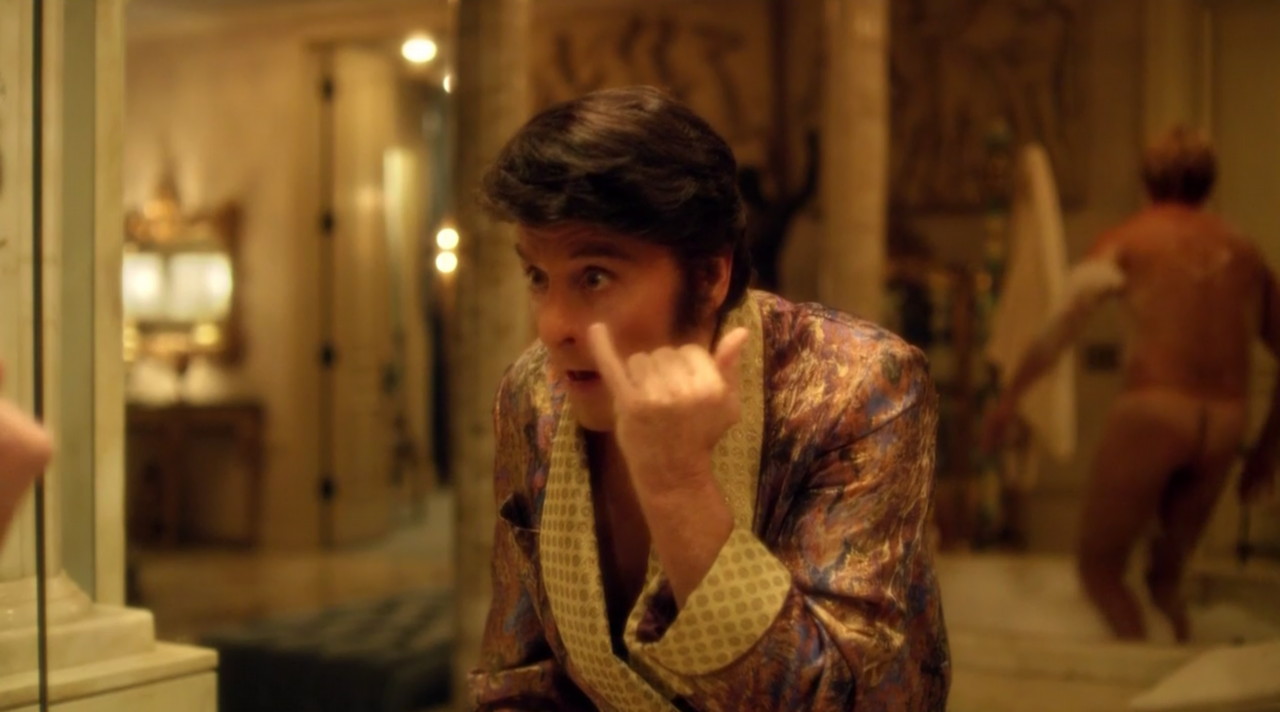By Armond White
From the actors’ perspective, Behind the Candelabra looks like a compassionate portrayal of the pianist and singer Liberace‘s relationship with Scott Thorson. The older established celebrity’s involvement with a younger man, masked for the public from 1977 to Liberace’s death in 1987, gets exposed here as an example of the deception then practiced by some gay performers. The title of this HBO production either criticizes-or-ridicules the closet but as Michael Douglas portrays Liberace and Matt Damon portrays Thorson, there’s also a strange confession of the weaknesses and dependencies that occur in such insecure and unstable showbiz relationships.
 The film itself feels unstable partly because Richard LaGravanese’s screenplay starts from Thorson’s memoir, taking the defensive view of a complainant in a palimony case. Behind the Candelabra shows Thorson as a “bisexual” with interest in becoming a veterinarian who, through association with gay hustlers, is picked up to be Liberace’s consort (one in a series). The pair go from friends to lovers to a filial partnership; Liberace proposes adopting Thorson to make their coupling legal; Thorson even undergoes plastic surgery to resemble Liberace (and to fit Liberace’s romantic ideal). Through the attrition and tension of intimacy (and drugs, sex and materialist escapades) they part acrimoniously, leaving Thorson thrown back on the working-class heap. A star is not born.
The film itself feels unstable partly because Richard LaGravanese’s screenplay starts from Thorson’s memoir, taking the defensive view of a complainant in a palimony case. Behind the Candelabra shows Thorson as a “bisexual” with interest in becoming a veterinarian who, through association with gay hustlers, is picked up to be Liberace’s consort (one in a series). The pair go from friends to lovers to a filial partnership; Liberace proposes adopting Thorson to make their coupling legal; Thorson even undergoes plastic surgery to resemble Liberace (and to fit Liberace’s romantic ideal). Through the attrition and tension of intimacy (and drugs, sex and materialist escapades) they part acrimoniously, leaving Thorson thrown back on the working-class heap. A star is not born.
Douglas and Damon attempt illuminating these men’s fragile humanity. (A shot of Rock Hudson’s death notice in a newspaper headline casts the fatal pall of AIDS.) Their almost fascinating commitment to these roles–portraying romantic and social clowns putting forth fronts for peers, audiences and each other–bounces back on the stars’ own artistic dedication. After years of seeing Douglas play scoundrels and Damon as politically-correct paragons, they (even when bare-assed) can’t help but lend villainy to Liberace and victimhood to Thorson. It’s Douglas and Damon’s stock-in-trade–and possibly what they best understand about human nature: the greed and selfishness of power and the resentment and ambition of the powerless.
Regrettably, this approach also limits Behind the Candelabra to stock characterizations. Another aspect of the film’s instability comes from its conceit that by looking back at the wreckage of Liberace and Thorson’s closeted lives, the film makes an au courant Marriage Equality parable. But Marriage Equality (a tortured euphemism for gay rights) wouldn’t resolve a relationship where partners are unequally joined or whose mutual exploitation contradicts monogamous commitment or is based on unspecified consensual deals that differ from traditional fidelity.
These complexities–the conditions of partnership and details of character that override the Marriage Equality issue–get mixed up with the inexact parallels of Liberace and Thorson’s quasi-liberated lives. Too often Douglas’ sympathetic performance looks and sounds wide-eyed and goofy-voiced like Carol Channing while Damon improbably suggests Cesar, Caligari’s childlike creature without a will of his own, yet petulant.
In depicting these wildly luxurious and disingenuous lifestyles, director Steven Soderbergh seems to confuse Liberace and Thorson with the out-gay Las Vegas magicians, Siegfried and Roy. Behind the Candelabra is partly, unmistakably, a freak show (Magic Mike II). And this is where the actors’ empathy and the director’s condescension collide. It recalls that ungracious moment in George Clooney’s Good Night and Good Luck taking a gratuitous slam at Librace, ignoring the fact that his flamboyance was never totally deceptive. Liberace’s public (like Little Richard’s) always “knew.” (Liberace was the Elton John of his times, a glitzy dresser and colorful entertainer to all.)
Soderbergh can’t find an appropriate moral context for this story. Using the glib cynicism he learned from Mike Nichols, the sordid aspects of Liberace’s repression and Thorson’s denial (porn shop cruising, drug deals, surgical quacks, agents and lawyers) turn into a roman a clef circus performed by a bevy of comic pranksters: Dan Ayckroyd, Rob Lowe, Scott Bakula, Paul Reisner–and Debbie Reynolds as Liberace’s money-grubbing mother. Soderbergh’s dismissive treatment ignores Liberace’s artistry, judging his showmanship not for its skill and friendly kitsch but as proof of bad taste rather than emotional generosity. This beauty-and-the-beast concept is what’s kitschy. But in the great 1946 film Beauty and the Beast, Jean Cocteau advised “Love can turn a man into a beast. But love can also make an ugly man handsome”–which says more than Soderbergh does about both Liberace and Thorson’s feelings. In Behind the Candelabra such human understanding becomes as out-of-focus as Soderbergh’s videography.
***
Strange that so many media people go stupid–totally gullible–when Steven Soderbergh holds forth about the “art of film.” (He promises a sabbatical from filmmaking to concentrate on painting, TV and esthetics.) Soderbergh pretends that cinema is a mysterious, arcane calling whose century-old principles and potential are yet to be discovered–even though Soderbergh photographs his own movies (under the pseudonym Peter Andrews) as if he never heard of light or focus. The great cinematographer Henri Alekan who shot Cocteau’s Beauty and the Beast (as well as Wim Wenders’ Wings of Desire) made remarks that Soderbergh should heed: “Technology has been perfected but one thing has not changed: style, taste, creativity and imagination.”
Follow Armond White on Twitter at 3xchair
